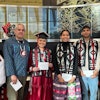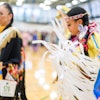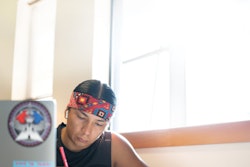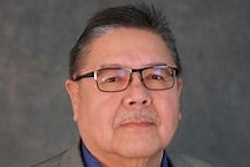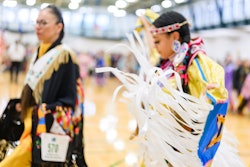Native Americans have long struggled to battle Hollywood stereotypes, correct the distorted “official” histories found in textbooks and museums and present their stories on their own terms.
It is not surprising that a group of Native American scholars and activists is gearing up for an effort to rewrite their history to clarify the true scale of their historical oppression. The struggle to correct the record is happening at the National Museum of the American Indian (NMAI). Since its 2004 opening, the NMAI has been a source of pride as a prominent national exhibit dedicated to the preservation and study of Native American culture but one that critics say inadequately represents the persecution of Native Americans.
The NMAI is the newest of 19 museums and nine research centers that make up the Smithsonian Institution, the world’s largest museum complex and research organization.
The Native American activists, attorneys and scholars involved in the creation of the NMAI intended it to be a place where American Indians would have everything they needed to tell their true story. The NMAI offered its director, curators and historians unprecedented levels of institutional clout and intellectual freedom and access to a world-class collection of Native American artifacts.
However, when the museum opened in Washington, its permanent exhibits left many disappointed and exposed the staff to a storm of condemnation from critics, including several prominent American Indian scholars. To explain how such a promising effort fell short requires an understanding of the tricky politics of exhibiting public history and opens a new chapter in Native Americans’ troubled relationship with museums, particularly with the Smithsonian.
Difficult Journey
“When I was getting my Ph.D. in sociology, the idea of working for the Smithsonian was unthinkable,” says Dr. Gabrielle Tayac, a member of the Pequot tribe and a curator at the NMAI. “Telling someone you wanted to become a museum curator was almost like saying you were joining the enemy.”
Tayac gives three reasons for this distrust of museums. First, Native American art and history were not usually exhibited alongside the ancient Greeks or Romans but displayed in natural history museums along with “primitive” peoples, animals, and extinct species. In addition, most exhibits perpetuate the idea that Native Americans have died out, making it harder for the 2.4 million Indians living in the U.S. to struggle for basic rights. Finally, many institutions used violence or theft to acquire their huge collections, which often included human remains and sacred religious objects.
“During the 1860s the U.S. Army Museum and the Smithsonian Institution actually placed advertisements asking people to raid Indian graves,” says Suzan Shown Harjo, a Cheyenne and Hodulgee Muscogee advocate who served on the board of directors of the NMAI and its sister facility in New York.
In efforts to reclaim their history, American Indian activists organized protests in the late 1960s that led to passage of the Native American Graves Protection and Repatriation Act. Those protests planted the seeds for NMAI, Harjo says. The new law forced many museums to give human remains and certain other artifacts back to native tribes. Although opposed by some curators who considered these materials necessary for legitimate scientific study, institutions that received federal funds had to comply.
These political developments came about just as the world’s largest private collection of Native American objects came onto the open market. In the early 1900s, New York state millionaire banker George Gustav Heye aggressively collected Indian artifacts because he believed their culture would soon die out. He died in 1957 and by the late 1980s his Museum of the American Indian was in such trouble the trustees decided to protect the collection by selling it, preferably to someone who could keep it in one piece.
According to Harjo, billionaire Ross Perot wanted to buy the collection and move it to his home in Texas, but local politicians fought to keep it in New York. The federal government escalated the bidding war when the Smithsonian announced that it should house this national treasure in Washington.
After intense negotiations, New York officials, federal government representatives, and Native American activists, including Harjo and renowned Indian attorney W. Richard West Jr., arrived at a complex compromise. The Indians agreed to let the Smithsonian hold these and other collections and assume the expense of conserving them. In return, Native Americans would control how their materials and history were exhibited and interpreted. To make the deal work, Congress created the National Museum of the American Indian, which consists of three entities. Heye’s collection was renamed the George Gustav Heye Center of the NMAI and relocated to modern facilities in the U.S. Customs House in lower Manhattan, N.Y. A scholarly research center was created in Suitland, Md. The crown jewel was a new museum built on the National Mall.
“I thought it was great to get the location closest to the U.S. Capitol,” says Harjo. “We wanted to get right up in Congress’ face and say, ‘After 500 years, America can’t ignore us any more.’”
West, the museum’s first director, was determined that the museum’s exhibit-making process would incorporate native ways of knowing with oral testimony from living Indians considered as important as academic sources. The staff, which included an unprecedented number of Native Americans, engaged in lengthy collaborations with tribal leaders. The NMAI decided that the most important message that it could send to its visitors was that Native Americans were not vanished or gone. “We’re still here,” became the main theme when the museum opened.
A series of ceremonies marked the museum’s opening. “Many of the Native people who came to visit were overwhelmed with emotion at finally seeing a museum dedicated to American Indians on the Mall,” Tayac says. “The closest thing I ever experienced to it again was seeing African-Americans weeping on the night that Barack Obama was elected president.”
Omission Accomplished
It’s not surprising that most Indians who visited were pleased with the $110 million institution. Its dramatic architecture was reminiscent of the Pueblos of the Southwest. The sophisticated landscaping incorporated corn, beans, squash and tobacco—basic staples of Indian life. The museum’s Mitsitam Café featured authentic dishes such as juniper planked salmon or Native American-inspired food such as buffalo burgers. The fourth-floor galleries dedicated to American Indians’ history and worldview had labels developed by and with Native American thinkers.
What NMAI didn’t have were groundbreaking exhibits that gave America a new perspective on Native American history. The overall critical and scholarly response to the exhibits was generally negative. In a 2006 The American Indian Quarterly article titled “Missed Opportunities: Reflections on National Museum of the American Indian,” Dr. Amy Lonetree, an assistant professor of American studies at the University of California, Santa Cruz, argued that the museum attempted to convey the history of Native Americans without directly confronting the 500 years of deliberate and accidental genocides that nearly wiped them out.
The problem is that the permanent exhibits do not contain many accurate references to massacres, smallpox and other diseases carried by European settlers or broken agreements. One panel describes how early Spanish explorers held an Indian king for ransom but then strangled him to death after his people delivered the gold demanded for his release. The disappointment is that little in the museum communicates a powerful feeling of righteous anger. Nowhere is there a large, clear statement that the Americans who visit today are the heirs to a legacy of atrocity. Nothing screams out that the assault was 200 years longer than African slavery and as deadly as Adolf Hitler’s Final Solution.
After the opening, the Native American Times reported that Clyde H. Bellecourt, national executive director of the American Indian Movement (AIM), said, “They should have a wall to speak about the holocaust of the tribes who disappeared. They don’t say who was responsible for it. Our history is not being told.” AIM called for the museum to be renamed the National Holocaust Museum of the American Indian.
NMAI curators such as Tayac and Paul Chaat Smith, who wrote many of the historical labels, say the criticism hurt them but admit that some of it was justified. “No one here thinks we hit the nail right on the head,” says Tayac.
Chaat Smith sees the irony in the criticism. “The labels talk about the diseases that killed millions and assert that the Columbian encounter changed everything about the world we live in today,” he says, “but I’ve learned that most visitors don’t read labels and that subtlety is a waste of effort. We have a bitter joke that we ended up with the greatest story never told.”
How, after millions in research and years of consultation, could a museum on Native American history lack so much history? Chaat Smith says one explanation is the limitations of oral histories as a museum methodology.
“NMAI deliberately emphasized the voices of contemporary Native Americans,” he says. “However, like most people, they preferred to speak about their lived experience rather than historical atrocities that happened long before they were born.”
Kym Rice, the head of the museum studies department at George Washington University, supports his theory. Rice finds the major permanent exhibits disappointing and says, “I didn’t expect NMAI’s exhibitions to adhere so closely to what appears to be community-selected emphases, therefore ignoring historical context, colonialism and other factors in the process.”
Other explanations are more political. Harjo believes curators were intimidated into presenting a whitewashed perspective. “Proclaiming ‘We’re still here,’ means little without confronting the holocaust that killed 20 (million), 30 (million), maybe 40 million people,” she says. “That’s what makes it remarkable that any of us survived at all.”
To Be Continued
The necessity of continuously emphasizing that Native Americans are still here and lead modern, sometimes ordinary lives was demonstrated at the museum during an October afternoon. Upon exiting the elevators, a mother asked her young son if he’d learned anything new. “Yes,” he replied. “I never knew Native Americans used elevators.” Another visitor responded, “Indians who live in apartment buildings use elevators every day.” Misperceptions remain so common the staff has answered them with a book titled “Do All Indians Live In Tipis?”
While many critics consider the permanent exhibits a confusing failure, some experts, including Rice, still feel that the museum has accomplished a lot given all its conflicting demands.
“What they do very well is programming (that) really conveys that Native Americans have a continuous living culture,” she says. “I’ve seen some wonderful performances there. I also like the riskier, less conventional temporary exhibitions such as ‘Strange Comforts’ by artist Brian Jungen, who makes traditional Native American designs out of Air Jordan sneakers. Besides, I’ve heard that the staff is getting together to discuss giving new exhibits a sharper focus.”
Tayac confirms the museum’s new direction and Harjo has already started. “I’m curating an exhibit about treaties that discusses the good ones, the bad ones and the ugly ones without pulling any punches,” Harjo says.
Offering a holistic perspective on NMAI, Heciya Topa, a Native American lawyer and activist, notes his appreciation of all the struggles and compromises it embodies. “It’s just a joy and an honor to take my wife and daughter to visit our museum on the Mall,” he says. “Our people were silenced for centuries, so we have a whole lot to say and it’s only natural that we couldn’t say everything at once.”

